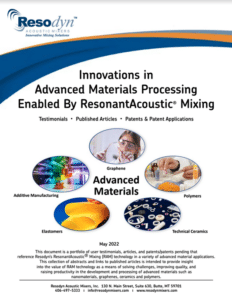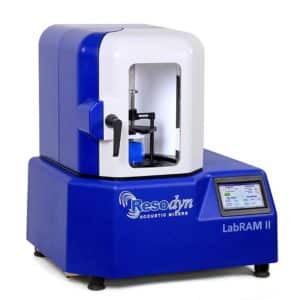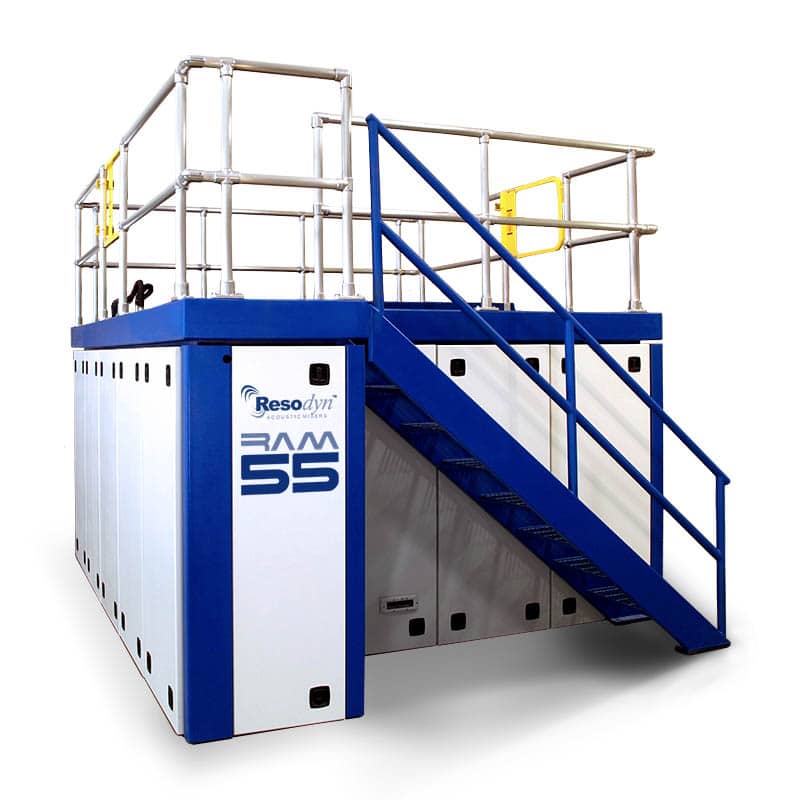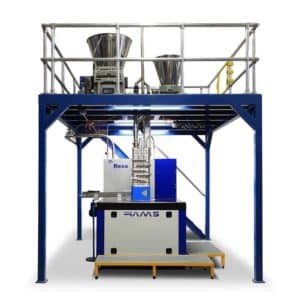



Home » Industries Served » Best Industrial Mixers for Electronics
RAM Mixers
The #1 Electronic Material Mixer

ResonantAcoustic® mixing (RAM) plays an important role in the electronics industry, where precise electronic material mixing is essential for manufacturing various components, circuits, and devices. RAM Mixers are used in a wide range of processes, from producing adhesives and coatings to creating electronic compounds and pastes. Here’s how RAM technology contributes to the electronics industry:
1. Manufacturing of Electronic Pastes and Compounds
- Solder Pastes: Solder paste, used in surface mount technology (SMT) for assembling circuit boards, requires precise mixing to ensure uniform consistency. RAM mixers blend solder powders with flux in a controlled manner, ensuring that the paste is stable, smooth, and ready for accurate application during the soldering process.
- Conductive Inks and Pastes: These materials are essential in applications like printed circuit boards (PCBs) and flexible electronics. RAM ensures that the conductive particles (such as silver or carbon) are evenly dispersed within the ink or paste, which is critical for maintaining the electrical conductivity and performance of the final product.
2. Mixing of Adhesives and Sealants
- Electronic Assembly: Adhesives, encapsulants, and sealants are used in electronic assembly to hold components in place, protect circuits from moisture, and ensure reliable connections. RAM mixes these materials, which may contain resins, hardeners, and fillers uniformly, leading to the desired bonding strength and durability in electronic devices.
- Polymer Compounds: In applications such as chip encapsulation or bonding of electronic components, RAM blends the polymer compounds to the correct viscosity, guaranteeing ease of application and optimal material performance.
3. Creation of Conformal Coatings and Other Types of Coatings
- Conformal Coatings: These coatings are applied to sensitive electronic components to protect them from damage. RAM evenly mixes the conformal coating materials, which may contain silicones, acrylics, or polyurethanes to maintain consistent performance in protective applications.
- Protective Coatings: Electronics, particularly circuit boards, often require protective coatings that shield them from environmental factors such as moisture, dust, and corrosion. Electronics manufacturers use RAM to prepare homogeneous coating materials, such as resins, solvents, and additives to create the required properties (e.g., viscosity, adhesion strength, and curing characteristics).
4. Thermal Interface Materials (TIMs)
- Heat Dissipation: Thermal interface materials (such as thermal pastes or pads) are used to manage heat between electronic components and heat sinks. RAM mixes these materials with precision to ensure the right balance of thermal conductivity, viscosity, and spreadability. TIMs need the consistent blending results RAM provides, improving heat dissipation and protecting sensitive electronic components from overheating.
5. Polymer and Resin Mixtures for PCB Laminates
- Printed Circuit Boards (PCBs): RAM rapidly blends polymer resins and fillers used in PCB manufacturing. The resins serve as the base material for PCB laminates, and RAM thoroughly mixes the resins to the proper consistency for lamination, preventing defects that could lead to signal degradation or manufacturing failures.
6. Microelectronics and Semiconductor Fabrication
- Photoresists: In semiconductor manufacturing, photoresists (materials used for photolithography) are mixed to the right viscosity and consistency before application to semiconductor wafers. RAM mixers are essential in achieving the correct dispersion of chemical components, which is critical for defining patterns and for precision during the manufacturing of microchips and integrated circuits.
- Etching and Deposition Processes: Chemical solutions used in etching and deposition processes also require consistent mixing to maintain uniformity. RAM prepares these solutions, in order to enable effective etching or depositing materials on semiconductor surfaces without producing defects.
7. Quality Control and Consistency
- Uniformity: In electronics, even slight variations in electronic material consistency can result in yield loss during manufacturing, poor performance, or malfunctioning devices. RAM blends raw materials evenly and repeatably, maintaining high product quality and reducing variability in the final products.
- Controlling Particle Size: Some electronic materials, such as conductive pastes and inks, require precise control over the particle size distribution. RAM enables specialized mixing techniques to control particle dispersion, which is essential for the performance of electronic components.
8. Automation and Process Efficiency
- Consistency and Reproducibility: RAM batch and continuous mixers, often automated, offer consistent and reproducible results, essential for large-scale electronics manufacturing. Automation reduces the risk of human error and ensures that batches of materials are mixed according to the same specifications every time.
- Reduced Labor and Time Efficiency: Automated options on RAM mixing systems speed up the preparation of materials, allowing electronics manufacturers to streamline production processes and meet the high demands of the industry.
Conclusion
In the electronics industry, ResonantAcoustic® mixers ensure the precise preparation of materials, whether it's for soldering, adhesives, pastes, coatings, or other components. By ensuring uniformity, consistency, and quality in the materials used, they are essential for the performance, reliability, and efficiency of electronic devices. They enable manufacturers to produce high-quality, functional, and durable electronic products with reduced waste and improved productivity. And If you are in need of a high viscosity mixer, please know Resodyn is second to none.
Resodyn Acoustic Mixers, Inc. provides a complete range of mixing equipment geared toward advanced electronics mixing. This low frequency (60 Hz) mixing system provides unparalleled consistency in performance and repeatability from which to base the advancement of material processing.
ResonantAcoustic® Mixing (RAM) technology has been the preferred embodiment for hundreds of Patents. RAM is simply the “best mode known” for consistent lab, bench, and commercial scale development of mixing innovations.
EXPERT
TESTIMONIALS
“... [ResonantAcoustic® mixing] is a fantastic technology. It has revolutionized the way we mix for development of materials for additive manufacturing...”
- Nik Ninos, Research and Development Manager, Calix Ceramic Solutions
“Resonant acoustic mixers from Resodyn have proven to be extremely valuable in graphene development for our clients. It is critical for nanotechnologies such as graphene to be processed with the level of exacting consistency and particle distribution, especially at low loadings, that RAM has proven to consistently achieve.”
- Research Scientist, European Nanomaterial Research Organization
“[We] mix different rheologies with powder metals, highly viscous, and the LabRAM II has proven it can do that effectively. We’re very impressed with the build quality of the mixer--it’s a nice, solid, well-thought-out piece of equipment. It’s done very well for us.”
- Managing Engineer, Major U.S. Research Laboratory
THE ELECTRONICS
MIXING SOLUTION
The ResonantAcoustic® Mixer (RAM) product line harnesses the power of resonance (low-frequency sound) to generate powerful and efficient mixing for dental labs of complex Solid-Solid, Solid-Liquid, Liquid-Gas, and Liquid-Liquid Blends. Benefits include:
- 10-100X faster mixing times
- bladeless non-contact mixing
- consistent homogenization
- no cleaning & no cross contamination
- highly reliable repeatability
- scalable
- built to last decades
- custom engineered systems
- unbeatable mix quality
- massive cost savings
- eco-friendly operation
- unmatched safety
HOW RAM MIXERS
CAN HELP YOU
Videos
Industry Folios
Patents
Dissimilar Powder Mixing
Dry ingredients can be difficult to thoroughly and consistently mix, particularly when the particles are of different sizes and characteristics. To illustrate effective and rapid mixing, 10 grams of fumed silica is blended with 100 grams of sand. Completed specimens exhibit no airborne fumed silica, demonstrating uniform blending at an order of magnitude difference in particle size.
Milling and Nano Coating
Coating larger particles with smaller ones is a common processing application, and milling is often a part of the same process. In this video, agglomerated carbon black particles are simultaneously milled to nano size particles that coat the plastic pellets completely in just a few seconds. The high speed video clearly illustrates the dispersion of carbon black particles, their de-agglomeration, and progressive and comprehensive coating of the plastic pellets.
Powder Incorporation in Viscous Liquid
Many polymer-based materials require the addition of dry or powder materials for specific performance characteristics or coloration. To illustrate dry powder incorporation in a viscous liquid, a small amount of dry ingredient is rapidly blended with a viscous liquid. The newly captured mixing phenomena reveal how the thoroughly blended and uniform mixture is achieved in a very short mixing time.
Loaded Polymer Blending
To illustrate a heavily loaded polymer blend, two materials of very different particle sizes are blended with a polymer surrogate. This footage documents the nature of the material blending and integration into a heavily loaded (~85%) polymer based paste. The use of RAM™ technology is ideally suited for loading of solids into polymers and mixing to a high rate of dispersion and consistent viscosity throughout the blend.
Download these folios of insightful testimonials and links to informative technical papers, articles and patents involving RAM’s impact on the development and use of:
ELECTRONICS MATERIALS PROCESSING
MIXING PRODUCTS
LabRAM II
1,000 gram capacity for repetitive and small sample processing
Up to 2.2 lb (1,000 gram) payload capacity full-featured, digitally controlled batch mixer for bench-scale development, mixing, and processing.
RAM 55
420 kg capacity delivers bench development through large-scale batch production.
Batch payload capacity up to 924 lbs (420 kg). RAM 55’s digitally controlled, multiple processing capabilities multiply RAM’s value through direct and easy scale-up from bench development to large scale batch production.
Continuous Acoustic Mixer (CAM)
High throughput mixing for pilot and production scale
Continuous Acoustic Mixing (CAM) systems are configurable for OmniRAM, RAM 5, and RAM 55. CAM systems are custom built for the application and enable high-throughput acoustic mixing of powders, pastes, and liquids.















